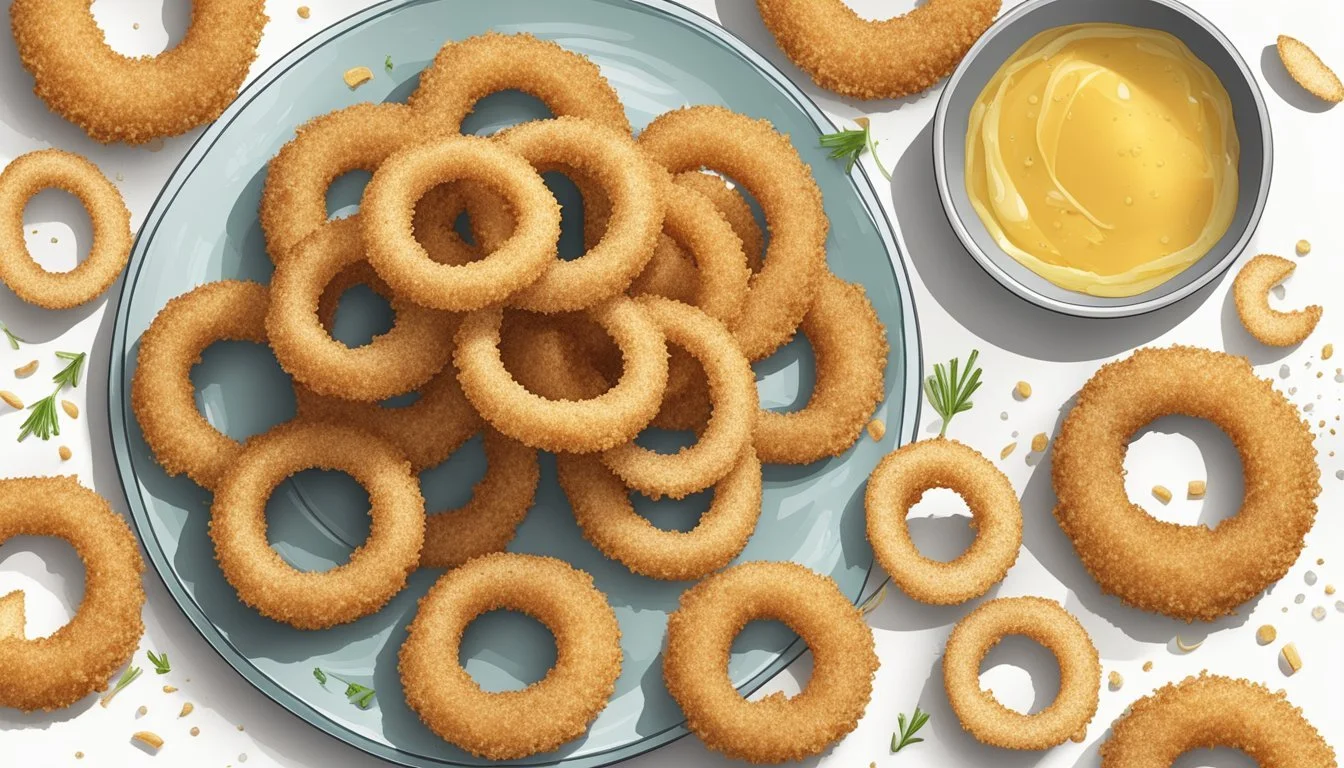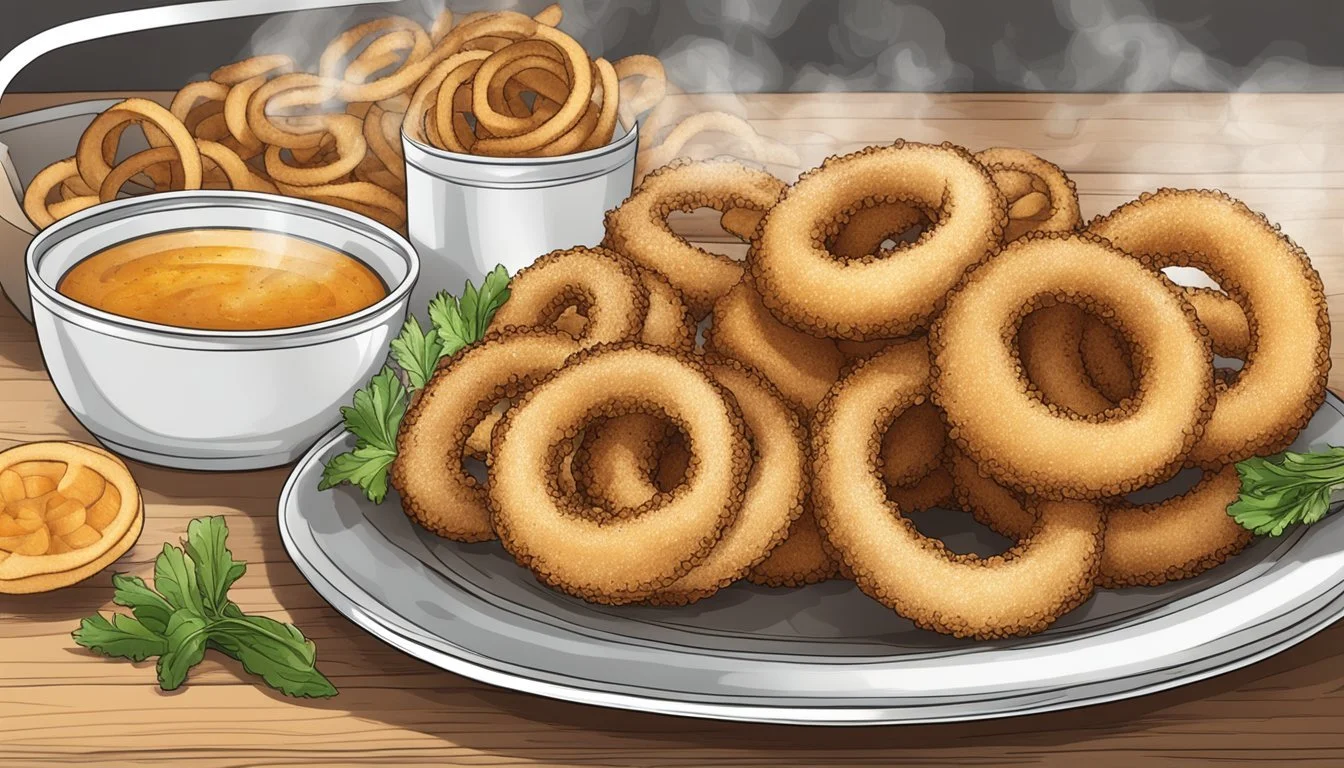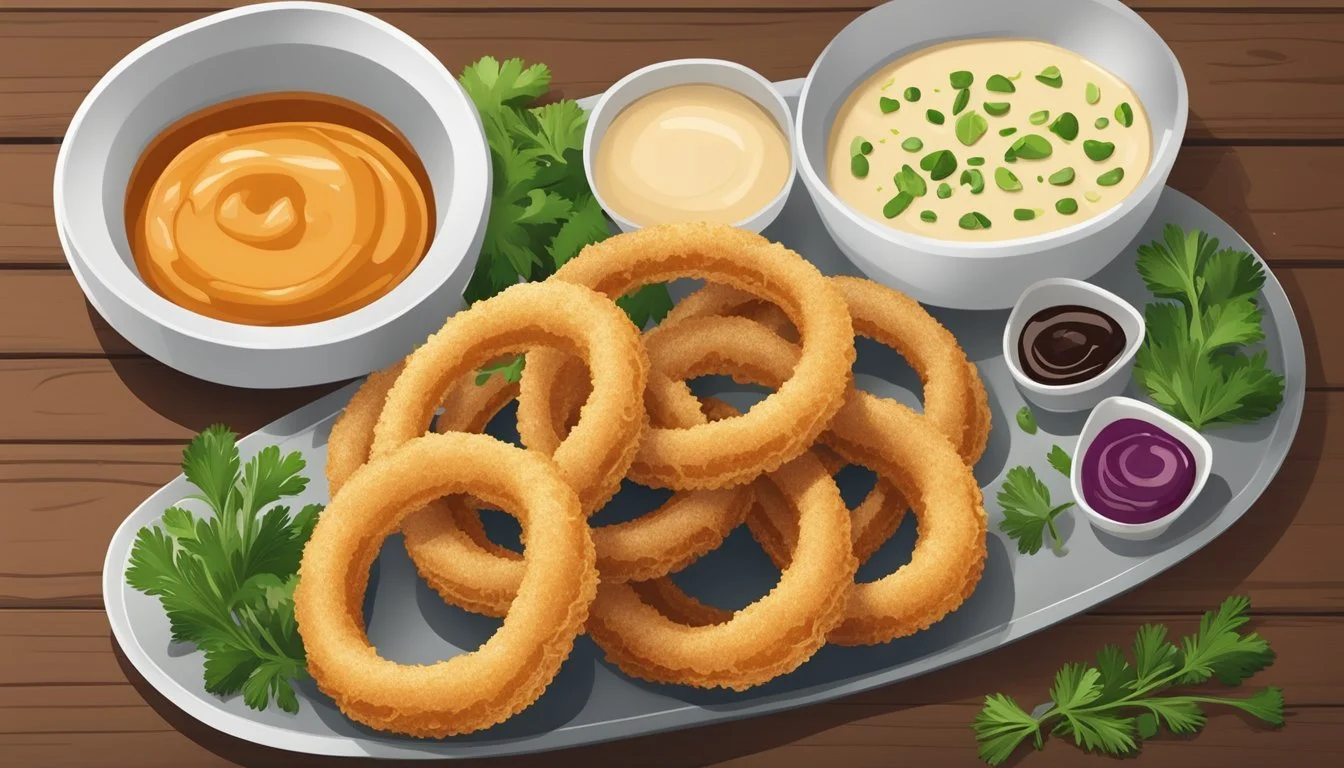How Long Do Gluten-Free Onion Rings Last?
Storage Tips for Freshness
Homemade gluten-free onion rings bring a delicious crunch to any meal, but knowing how long they last is crucial to avoid waste and ensure freshness. Stored properly in an airtight container in the refrigerator, gluten-free onion rings can last up to three days. This gives you a few days to enjoy your tasty treat without worrying about it going bad.
Beyond this period, their texture and taste may begin to decline. Reheating in an oven or air fryer can help restore some of the crispiness, but it's best to consume them sooner rather than later. For longer storage, you might consider freezing the onion rings, which can extend their shelf life to about one month.
Understanding the shelf life of your gluten-free onion rings helps in meal planning and ensures you can enjoy your food while it's still at its best. This simple knowledge can save time and reduce food waste in your kitchen.
Understanding Gluten-Free Onion Rings
Gluten-free onion rings offer a delightful alternative to traditional recipes, using ingredients that cater to those with gluten sensitivities or celiac disease. This section explores what makes them distinct and the benefits they provide.
Definition and Benefits of Gluten-Free
Gluten-free onion rings are prepared without gluten-containing ingredients like wheat flour. This makes them suitable for individuals with gluten intolerance or celiac disease. Gluten-free diets can help reduce symptoms such as bloating, headaches, and fatigue in sensitive individuals.
Gluten-Free Onion Rings may also appeal to a broader health-conscious audience seeking lighter, easily digestible snacks. These onion rings often have a unique texture and flavor profile, resulting from alternative flours and ingredients used.
Key Ingredients for Gluten-Free Onion Rings
The main ingredients are gluten-free flour blends, which can include combinations of rice flour, cornstarch, potato starch, and tapioca starch. These flours provide the necessary structure and crispiness without gluten.
Other essential components include baking powder for leavening, ensuring the coating is light and airy. Spices and seasonings like salt, paprika, and sugar are added for flavor.
The wet ingredients typically consist of milk, eggs, and oil, which help bind the dry ingredients and provide moisture. Alternative options like almond milk can be used for those with further dietary restrictions.
By carefully selecting these ingredients, one can achieve gluten-free onion rings that are crunchy on the outside while soft and flavorful inside.
Gluten-Free Onion Rings Preparation
Yellow onions provide the best balance of flavor and texture. For the batter, a careful mix of gluten-free flour, egg, milk, and other ingredients is crucial. Choose your cooking method based on your desired level of crispiness, with options including frying, baking, and using an air fryer.
Selecting the Right Onion
Yellow onions are ideal for gluten-free onion rings due to their slightly sweet flavor and firm texture. Choose medium to large onions for larger rings. Peel the onions and slice them into 1/4 to 1/2-inch thick rings. Separate the rings carefully to avoid breaking them. Ensuring even size and thickness helps them cook uniformly.
Creating the Perfect Batter
Mix together a gluten-free flour blend, baking powder, paprika, and salt in one bowl. In another, whisk together egg and milk (or use dairy-free milk if required). Combine wet and dry ingredients to form a smooth batter. Adjust the thickness based on preference—thicker batter for a heavier coating, thinner for a lighter finish. Letting the batter rest for about 15 minutes can enhance the texture.
Baking Vs. Frying Methods
For frying, heat about 2 inches of canola or vegetable oil to the correct temperature. Coat each onion ring in batter and fry for 1-2 minutes per side until golden brown. For a healthier option, bake at 425°F, flipping halfway through, for a lighter version while still achieving that crisp coating. An air fryer can also be used, set at 375°F for 8-10 minutes, providing a good balance between crispiness and reduced oil usage.
Seasoning and Flavor Enhancement
Gluten-free onion rings benefit from the right balance of herbs, spices, and dips. By incorporating the right seasonings and accompaniments, their flavor profile can be significantly enhanced.
Herbs and Spices
For a robust flavor, using a combination of paprika, garlic powder, and black pepper is essential. These spices give the onion rings a savory taste and a bit of heat. Paprika adds a smoky depth, while garlic powder brings a pungent, savory note. Adding a pinch of cayenne pepper can introduce a mild spiciness, perfect for those who enjoy a bit of kick.
Salt is crucial for enhancing all these flavors.
Experiment with dried thyme or oregano for added aromatic notes. An even coating ensures every bite is flavorful. Rice flour and tapioca flour in the batter can help the seasonings stick better to the onion rings.
Dips and Accompaniments
The right dipping sauce can elevate onion rings from a simple snack to a gourmet experience.
Ketchup is a classic choice and works wonderfully with the spices in the onion rings. Spicy mayo made with a blend of mayonnaise and sriracha or other hot sauce adds creaminess and heat. For a tangy alternative, try a yogurt-based dip with lemon juice and herbs. Another option is a barbecue sauce, offering a smoky complement to the paprika.
For those who prefer a bit of sweetness, a honey mustard dip combines tanginess with a touch of honey, enhancing the onion rings' crispiness. A ranch dressing is also a popular, creamy choice, balancing out the spices with its cool flavor.
Gluten-Free Onion Rings Storage Solutions
Proper storage and reheating practices are crucial to maintaining the texture and taste of gluten-free onion rings. Understanding how to store them properly can help maximize their shelf life and ensure they remain crispy when reheated.
Proper Storage Techniques
To store leftover gluten-free onion rings, place them in an airtight container. Keep the container in the refrigerator to prevent spoilage and preserve freshness.
For longer storage, freeze the onion rings by first spreading them out on a baking sheet in a single layer. Once frozen, transfer them to a resealable freezer bag. This method prevents them from sticking together and makes it easy to reheat individual portions.
Maximizing Shelf Life
Refrigerated gluten-free onion rings can last up to 1-2 days. Store them in an airtight container to maintain their crispiness. To keep them for a longer period, freezing is recommended.
Before freezing, ensure the onion rings are completely cooled to avoid excess moisture, which can lead to sogginess. When properly frozen, gluten-free onion rings can last for up to a month without significantly losing their quality.
Reheating Without Compromising Quality
For best results, reheat refrigerated gluten-free onion rings in an air fryer at 400ºF for 3-5 minutes. Alternatively, use an oven at 400ºF for 5-7 minutes. Both methods help regain the crispiness without making them greasy.
Avoid using a microwave, as it can leave the onion rings soggy. If reheating from frozen, increase the reheating time slightly to ensure they are heated through without burning. This careful reheating process helps restore the crunch and taste, making them enjoyable even after storage.
Health and Dietary Considerations
Gluten-free onion rings cater to a variety of health and dietary needs, providing an alternative for those with specific restrictions and preferences. These onion rings can be adjusted to fit various dietary lifestyles, ensuring they remain a delicious and accessible option for many individuals.
Nutritional Information
Gluten-free onion rings typically use gluten-free flour such as rice flour or brown rice flour, which can alter the nutritional profile. Generally, they are lower in protein compared to those made with wheat flour. The exact nutritional content will depend on the specific ingredients used and the cooking method.
For instance, baked gluten-free onion rings may contain fewer calories and less fat compared to deep-fried variants. It's essential to check the nutrition label on commercial gluten-free onion rings or calculate the nutritional content when made at home, considering factors like oil used for frying or baking.
Dietary Restrictions Adaptations
Gluten-free onion rings can be adapted to meet various dietary restrictions. For a dairy-free or vegan option, ingredients like non-dairy milk or plant-based egg substitutes can be used. Some recipes are already designed to be dairy-free and egg-free, utilizing gluten-free beer and rice flour for the batter.
Those with a preference for healthier oils can choose alternatives like vegetable oil or olive oil rather than canola oil. These adaptations ensure that individuals with diverse dietary needs—including those adhering to gluten-free, dairy-free, vegan, or other specific diets—can enjoy this savory treat without compromise.
By accommodating these dietary restrictions, gluten-free onion rings become an inclusive snack choice that aligns with various health-conscious and dietary preferences.
Tips and Tricks for the Best Outcome
Achieving the perfect gluten-free onion rings involves specific cooking techniques and thoughtful ingredient substitutions and variations. Paying attention to these details can make your onion rings deliciously crispy and satisfying.
Cooking Techniques
To ensure crispy and crunchy homemade onion rings, use the right cooking techniques.
Frying in a Dutch oven or a heavy-bottomed pot helps maintain a consistent temperature. Use a thermometer to keep the oil at about 350°F. Overcrowding the pot can lead to soggy rings; fry in small batches instead.
For baked onion rings, preheat the oven to 425°F. Arrange rings on a greased baking sheet or use parchment paper. Flip halfway through to ensure even crispiness. Spraying rings with cooking oil before baking can enhance the crunch.
Ingredient Substitutions and Variations
Substitutions can influence the texture and flavor of onion rings. Rice flour mixed with cornstarch makes the batter extra light and crispy. To keep the recipe dairy-free, use almond milk or another plant-based milk. For egg replacements, flax seeds or chia seeds mixed with water work well.
Variations allow you to experiment. Different onion types, like Vidalia or red onions, can change the sweetness and crunch. Adding spices like paprika or garlic powder to the batter provides extra flavor. For a low-carb version, almond flour can replace regular gluten-free flour.
Using these tips and tricks ensures that gluten-free onion rings turn out perfect every time.
Gluten-Free Cooking Beyond Onion Rings
Gluten-free cooking extends far beyond making just onion rings. Other gluten-free appetizers and expanding your culinary skills in gluten-free recipes can offer enjoyable experiences.
Related Gluten-Free Appetizer Ideas
There are numerous gluten-free appetizers that can complement a variety of meals or serve as satisfying snacks.
One popular choice is gluten-free mozzarella sticks. Made with gluten-free breadcrumbs, the cheese sticks provide a delicious option for those avoiding gluten.
Alternatively, gluten-free beer batter recipes allow for tasty dishes like fried pickles or tempura vegetables. Gluten-free beer batter retains the crispiness and flavor without gluten, making it suitable for a range of fried appetizers.
In addition, simple, gluten-free dips such as hummus or guacamole can be paired with gluten-free chips or vegetable sticks. These provide quick and healthy options that cater to gluten-intolerant individuals while keeping preparation time low. Versatility in gluten-free recipes ensures that there is something to please all palates.
Expanding Your Gluten-Free Culinary Repertoire
Beyond appetizers, it’s beneficial to explore various gluten-free cooking techniques and recipes.
First, using different gluten-free flours, such as almond or coconut flour, can enhance both savory and sweet dishes. These flours work well in baking muffins, bread, and even pizza crusts, adding unique flavors and textures.
Second, incorporating gluten-free grains like quinoa or rice into main courses and side dishes can offer nutritious and filling options. These grains are excellent for making hearty salads or gluten-free risottos.
Additionally, experimenting with naturally gluten-free cuisines, such as Mexican or Thai cuisine, can broaden your meal options. Dishes like tacos with corn tortillas or Thai curries with rice noodles can diversify the menu while being gluten-free.
In summary, mastering gluten-free cooking involves expanding beyond appetizers to include varied recipes and cooking techniques. This not only enhances meal variety but also ensures dietary needs are met deliciously.









